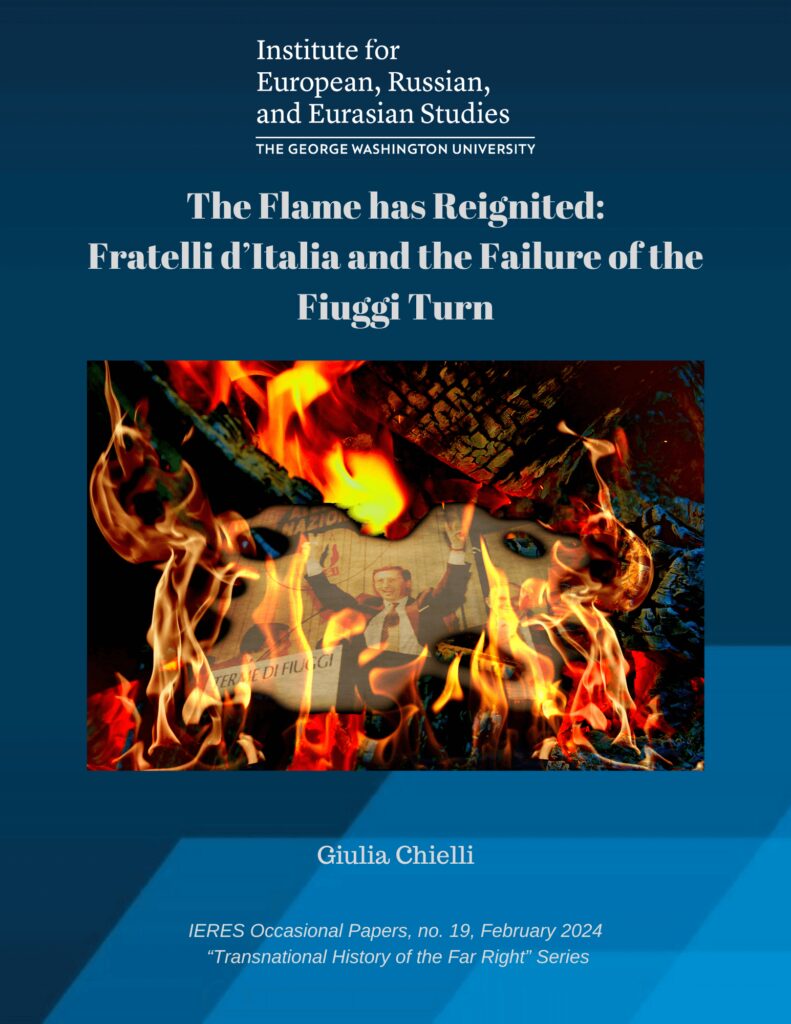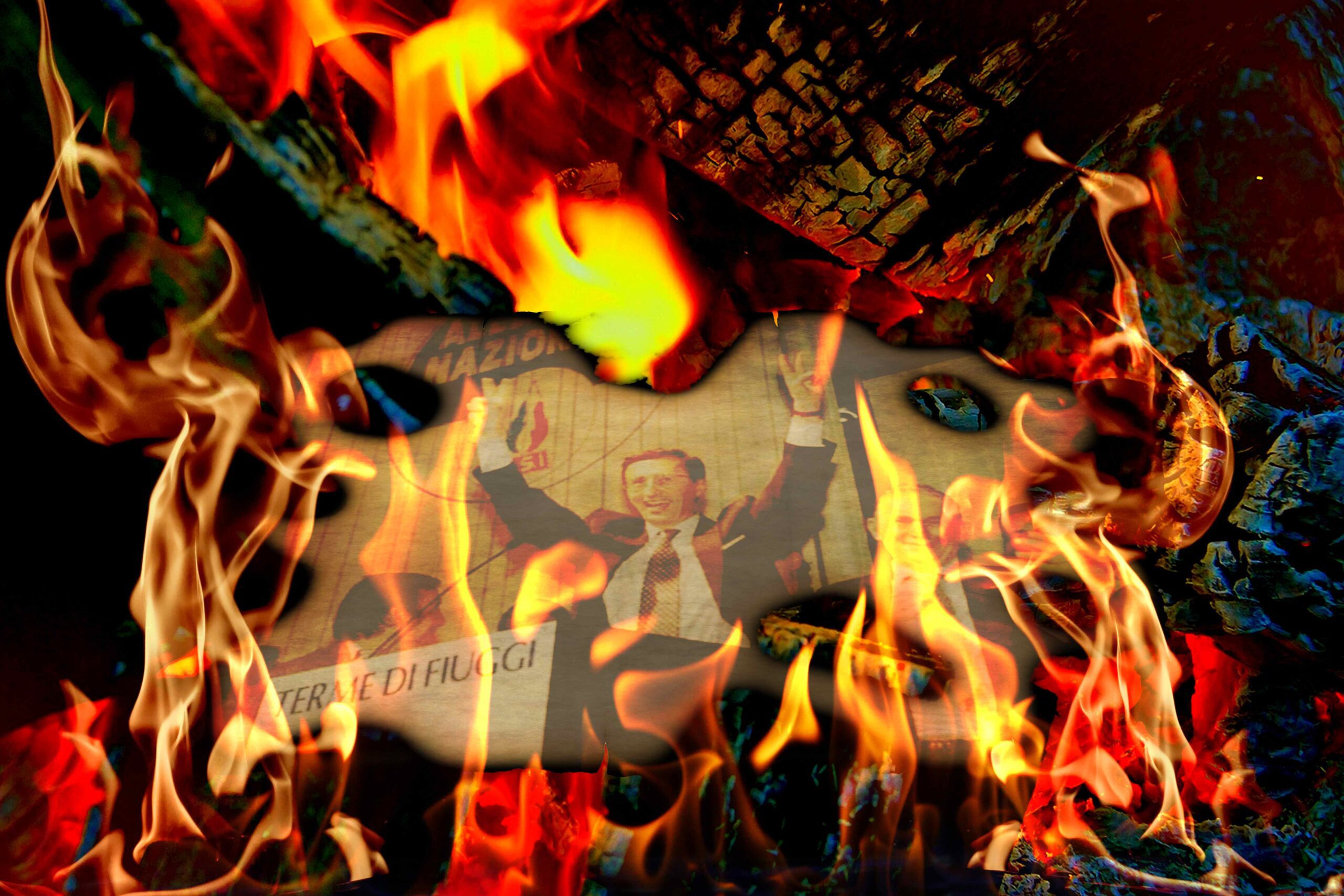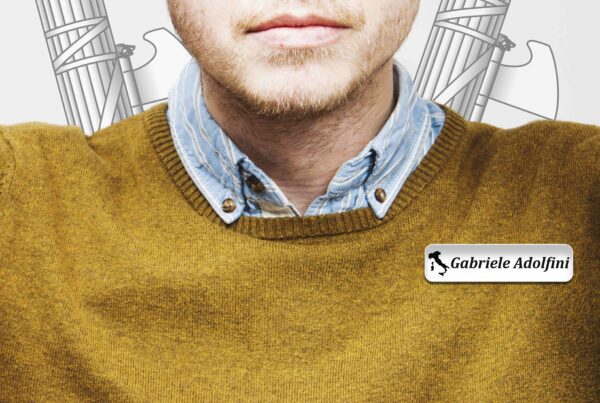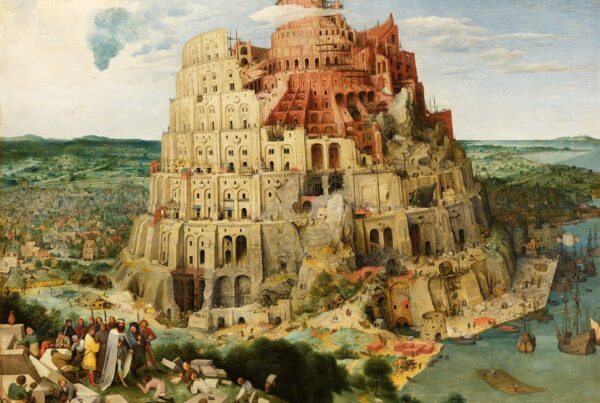
The Flame has Reignited: Fratelli d’Italia and the Failure of the Fiuggi Turn
By Giulia Chielli
IERES Occasional Papers, no. 19, February 2024 “Transnational History of the Far Right” Series
Photo: Made by John Chrobak using Glowing fire flame by Racool_studio on Freepik; Free photo flame of raging fire on Freepik
The contents of articles published are the sole responsibility of the author(s). The Institute for European, Russian, and Eurasian Studies, including its staff and faculty, is not responsible for any inaccurate or incorrect statement expressed in the published papers. Articles do not necessarily represent the views of the Institute for European, Russia, and Eurasian Studies or any members of its projects.
©IERES 2024
This article analyzes the relationship that Brothers of Italy (Fratelli d’Italia—FdI), the Italian political party founded and led by Prime Minister Giorgia Meloni, has with its predecessors, the Italian Social Movement (Movimento Sociale Italiano—MSI) and National Alliance (Alleanza Nazionale—AN). It explores how FdI positions itself related to the 1995 svolta di Fiuggi (Fiuggi turn), when the then-secretary of MSI, Gianfranco Fini, decided to set aside the fascist legacy of the party to give it a new liberal–conservative face.
The apparent death of Italian neofascism
The Kafkaesque metamorphosis of the MSI into the AN and the subsequent disappearance of AN following its merger into Silvio Berlusconi’s People of Freedom (Popolo della Libertà—PDL) in 2009 was not unanimously well-received in Italian neofascist circles[1]. While a portion of the MSI leadership was ready to sever its connection with fascism by abandoning the ambiguous role of the “fascist in democracy”[2] and moving toward full integration into the democratic system, another faction saw Fini’s maneuver as the definitive failure of the decades-long neo-fascist experience in republican Italy: a genetic change that altered the features of the MSI and brought about a profound mutation.
The political scientist Marco Tarchi expressed a shared sentiment within the neo-fascist environment in an April 2009 Diorama piece, written shortly after the birth of the PDL: “With the merger of the National Alliance into the People of Freedom, the story of Italian neo-fascism seems to have reached its destination,”[3] lamenting the right-wing leadership’s decision to abdicate the battle for cultural hegemony to which many neo-fascist intellectuals had devoted considerable efforts.
In the immediate aftermath of this event, it seemed that Tarchi might be proven right. The brief experience of the AN’s union with Silvio Berlusconi’s Forza Italia, its collapse sealed in April 2010 by the now-iconic “Che fai, mi cacci?” (What are you doing, kicking me out?) from Fini to Berlusconi,[4] was followed by the dissolution of the PDL. All of these signs seemed to suggest that Fini’s conservative choice had irreversibly condemned the neo-fascism that had survived decades of Italian political life and even the Tangentopoli[5] scandal.
The birth of Brothers of Italy: a mimicking of history?
Then, in 2012, from the ashes of the AN emerged FdI, a party founded by Giorgia Meloni, Ignazio La Russa, and Guido Crosetto that openly embraced the pre-Berlusconi experience, even in its symbol: a tricolor flame[6] that connects the new party with its MSI and AN predecessors. While the newborn party only garnered two percent of the votes in the legislative elections of the following year, today’s political landscape is drastically different. In the elections of October 2022, FdI emerged as the leading party with 26% of the preferences, and Giorgia Meloni became the first female Prime Minister in the history of Italy. In addition to this being the first time that a woman has held this position in Italy, it is also the first time that the Prime Minister is a representative of the party stemming from the post-fascist tradition[7], and that this party leads the government coalition.
In the long term, therefore, it seems that the Fiuggi turn has borne fruit: Italian neo-fascism may have been extinguished, as argued by Tarchi, but the new political entity born from that extinction has achieved a triumphant result, not even remotely conceivable even by the most optimistic of the missini (followers of the MSI). Yet, this perception is nothing more than a smokescreen cleverly positioned to disguise a very different reality.
To justify this statement, one must go back to the starting point, namely the Fiuggi turn. Gianfranco Fini’s idea was revolutionary in the world of Italian neo-fascism: the former protégé of Giorgio Almirante wanted to lead his followers “out of the sewers.”[8] His project was to transform the MSI, which had been located outside the constitutional framework since its inception, into a liberal–conservative governing force. He believed that after fifty years in which the missini had lived in the shadow of fascism, constantly searching for a solution to the irreconcilable antithesis of “fascism in democracy,”[9] the time had finally come to embrace democratic values and consign the Ventennio (the twenty years of fascism) to history,[10] departing from what had been the party’s motto for decades: “Non rinnegare, non restaurare“ (Do not deny, do not restore).[11]
Political scientist Piero Ignazi highlights how from the outset, in the new party, “beyond the image, continuity prevails in the organization, in the leadership, and to a large extent, also in the ideology.”[12] However, this was also, undoubtedly, a historic turning point. The rhetoric of a discourse that recognized anti-fascism as the foundational value of the Italian Republic could not constitute, in itself, an epochal and debated change; instead, it meant accepting the democracy that fascism first and neofascism later had fiercely opposed.
This change was profound to the extent that the more extremist wing of the party, the one that felt more connected to the legacy of the Republican fascist tradition led by Pino Rauti, did not accept the mutation. They decided not to join the AN and instead founded the party Movimento Sociale Fiamma Tricolore. However, Giorgia Meloni, who had started her political activism in the youth movements of the MSI, elected to remain in the party and follow Fini in his liberal–conservative project. When Fini decided to end the AN and participate in the founding of the PDL party, Meloni also followed and even took on the role of Minister for Youth in the fourth Berlusconi government (2008–2011).
Giorgia Meloni, on the other hand, who had started her political activism in the youth movements of the MSI, decided to remain in the party and follow Fini in his liberal-conservative project. When Fini decided to end the life of AN and participate in the founding of the People of Freedom party, Giorgia Meloni once again joined the project and even took on the role of Minister for Youth in the fourth Berlusconi government (2008-2011).
The beginning of Giorgia Meloni’s ascent to the leadership of the party and the government coincided with the end of the alliance with Berlusconi’s forces. After the dissolution of the PDL party, there was a return to the fold: Berlusconi’s supporters refounded Forza Italia, and the former members of the AN reconstituted around Giorgia Meloni, Guido Crosetto, and Ignazio La Russa in FdI. While this appeared to align with the AN, divisions began to emerge between the new leadership and the protagonist of the Fiuggi turn from the very beginning.
Gianfranco Fini expressed severe criticisms of what, in his eyes, was an attempt to resurrect a political experiment that had run its course: “It is worth reflecting on how the leaders of Brothers of Italy try to bring back National Alliance. After cleverly inserting the symbol, albeit in bonsai format, into their electoral logo, they celebrate the national congress in Fiuggi this weekend. I say to Brothers of Italy to stop mimicking history.“[13]
But Fini was mistaken. Giorgia Meloni’s project was not to mimic the history of AN, but rather to use it to her advantage. The Fiuggi turn had marked the political death of Gianfranco Fini: his attempt to give what had been the MSI a conservative party image perfectly integrated into the democratic system had diluted its original identity and placed it in a failed competition with the rising star of Italian right-wing politics: Silvio Berlusconi. Refounding AN as it was would have meant dedicating it to an almost certain electoral failure.
Brothers of Italy and its relationship with fascism
Meloni’s imagined strategy was more subtle. Despite the political fiasco, the Fiuggi turn had the significant advantage of separating the doubts and uncomfortable questions about the relationship with the fascist past away from the party, washing away the shame of the original sin. Giorgia Meloni’s challenge was to rebuild the party’s identity without overtly turning the clock back to a time of nostalgia but instead leveraging Fini’s political sacrifice without repeating his failure. The young leader decided to place FdI in a sort of continuity with AN, establishing a real filial relationship between the two that was conveyed through the symbol of the new party and the founding congress held in Fiuggi. This would serve a legitimizing function: including FdI in the history of AN acted as a certificate of closure with fascism without having to reaffirm its relevance.
Assuming that there was an inheritance transmitted from AN to FdI and that the Fiuggi turn was part of this inheritance, the message was conveyed that what Fini had said and done constituted a shared position by the leaders of the new party, even if they refrained from reaffirming it or making it a foundational element as was done by the founder of AN. Thus, every time Meloni is asked about her relationship with fascism, the Prime Minister always plays the card of “silence implies consent,” citing her presence in the party at the moment when Fini stated that fascism is absolute evil, and therefore her tacit adherence to the course set by the AN leader.[14]
However, a careful analysis reveals that reality is quite different; the legacy of AN, namely its distancing from fascism, is more superficial than one might imagine. A significant number of FdI parliamentarians and local government members find themselves at the center of scandals caused by statements praising Mussolini or the display of fascist symbols and gestures. The first to reveal a thinly veiled nostalgia is one of the party’s co-founders, currently the second-ranking official in the state, Senate President Ignazio Benito Maria La Russa.
In addition to the notoriety of his private collection of Mussolini busts, La Russa raised his arm in parliament mimicking the Roman salute on two occasions. In 2017, La Russa opposed the Fiano legislative proposal to punish the crime of propaganda for the fascist regime. During the pandemic, he suggested that a more hygienic Roman salute would be preferable to handshakes as a greeting. Not even his current prominent institutional role has managed to temper his positions. On the occasion of the Liberation from Nazi-fascism celebration (April 25), a celebration always contested in neo-fascist circles, in 2023, he stated that the Italian constitution is not anti-fascist. One month prior, commenting on an event from the Second World War that occurred on March 23, 1944, in which partisans killed 32 German SS soldiers from the third battalion Polizeiregiment, he indulged in historical revisionism, asserting that the 32 victims were not Nazis but retirees from Alto Adige.
La Russa is not the only politician to exhibit such behavior. Some FdI members or affiliates have also worn SS uniforms (including municipal councilor Gabrio Vaccarin in 2020) and engaged in Roman salutes (such as Lombardy’s security assessor Romano La Russa, Ignazio La Russa’s brother in 2022 and Ventimiglia municipal councilor Ino Isnardi in 2021). Isabella Rauti, undersecretary of defense in the Meloni’s government (and daughter of Pino Rauti) celebrated the anniversary of the founding of the MSI with the phrase “Le radici profonde non gelano” (Deep roots do not freeze).[15] It appears that not many members of FdI have come to terms with history.
Gianfranco Fini himself, now retired from politics, has repeatedly criticized his successors. He recently emphasized that he had distanced from AN the current FdI deputy Emanuele Pozzolo, who was involved in a scandal for firing a gunshot on New Year’s Eve, as a violent extremist.[16] On April 25, 2023, Fini also made a rather explicit statement in a television broadcast: “I hope Giorgia Meloni takes this opportunity to state without ambiguity and without reservations that the Italian right has come to terms with fascism thoroughly when AN was born.”[17]
Giorgia Meloni also appears to continue to engage in ambiguous behavior. On one hand, she does not openly reject the Fiuggi turn and, in fact, uses it to legitimize her supposed reckoning with history. On the other hand, she never misses an opportunity to claim a direct connection between the MSI and her party,[18] much more than she does with AN. Furthermore, Meloni has consistently avoided condemning even violent behavior with neo-fascist undertones. For instance, on October 9, 2021, a group of Forza Nuova neo-fascist activists protested against the Green Pass by assaulting the Rome headquarters of Italy’s major trade union, the General Confederation of Italian Labor (CGIL). In response, Meloni refused to acknowledge it as an episode of neo-fascist violence, stating that she was unaware of the ideological matrix of that act.
Meloni has also failed to distance herself from the annual gathering that has occurred every January 7 for 46 years in front of what was the MSI headquarters in Rome, where three young MSI militants were assassinated in 1978. Incredulous national and international observers[19] witnessed images of a multitude of men standing with their arms raised in the Roman salute and a collective shout of “Presente” after the pronunciation of the sentence “Per tutti i camerata caduti” (In memory of all fallen comrades).[20]
In the aftermath of the assembly, the opposition called for Meloni to distance herself. However, Meloni herself used to participate in this event; a photo from 2009 shows her in front of the Acca Larenzia headquarters with Giuliano Castellino (mentioned earlier in connection with his 2021 conviction for the riot at the CGIL headquarters). In light of this, the deafening silence in which the Prime Minister has barricaded herself is even more resonant. Just two years ago, when she was not the head of the government but only part of the opposition, she tweeted: “43 years ago, the massacre of Acca Larenzia. A wound never healed because there has been no justice. Let’s honour the memory of three innocent young people, victims of terrorism and political violence, and continue to demand that full light be shed on a dark page in Italian history.” [21]
Conclusion
Nearly 30 years after the Fiuggi turn, the issue of Italian neo-fascism appears to remain relevant. In the storyline from the MSI to the FdI, the brief life of AN and its distancing from fascism appears to be just a parenthetical aside, a useful link to provide the current governing party with a democratic background, but whose ideological premise is consistently denied by the statements and conduct of party members and their leaders. While the official discourse of FdI continues to assert that the accounts with fascism were settled in 1995, this behavior raises questions about the anti-fascism expressed by many members.
[1] In this context, by neofascist circles, we mean the collective of MSI militants and intellectuals who identified with or declared themselves aligned with the positions of the party.
[2] This is a statement by Giorgio Almirante, uttered in 1956 in Milan at the V congress of the MSI. In that occasion, Almirante stated: “L’equivoco, cari camerati, è uno e si chiama essere fascisti in democrazia. Noi soli siamo estremisti, ed è un titolo di onore, ma anche una spaventevole difficoltà per questa democrazia, per questa Italia del dopoguerra. E il nostro coraggio, vorrei dire la nostra audacia, è consistita, nel 1946, nell’inserirci come Msi cioè come un partito operante in questa democrazia” (The misunderstanding, dear comrades, is one, and it is called being fascists in a democracy. We alone are extremists, and it is a title of honor, but also a daunting challenge for this democracy, for this post-war Italy. And our courage, I would say our audacity, consisted, in 1946, in inserting ourselves as MSI, that is, as a party operating within this democracy).
[3] Tarchi Marco, “Verdetti della storia e senno di poi,” Diorama, n. 293, (2009).
[4] Vista Agenzia Televisiva Nazionale, “10 anni dallo scontro tra Gianfranco Fini e Berlusconi: “Che fai, mi cacci?””, 2020, YouTube video, https://www.youtube.com/watch?v=d2xh7l9VlTY, last access 01/12/2024.
[5] This term refers to a scandal that erupted in 1992, revealing a widespread system of political corruption. It was the cause of the collapse of the so-called “first republic” and the disappearance of almost all the parties that had inhabited it since the years immediately following the Second World War.
[6] The flame referred to is the tricolor flame from the symbol of the Italian Social Movement, which is also present in the symbols of National Alliance and Brothers of Italy. The March-April 2009 issue (number 293) of the Diorama magazine was titled: “Ora che la fiamma si è spenta” (Now that the flame has gone out), implying the end of the neofascist experience in the Italian political landscape.
[7] The tradition referred to is that of AN, the predecessor of FdI, and the party where Giorgia Meloni was a member. that has been considered post-fascists: compare, Ignazi, Piero, Il polo escluso: profilo storico del Movimento sociale italiano, Bologna, Il Mulino, 1998 ; Griffin Roger, “The ‘post‐Fascism’ of the Alleanza Nazionale: A case study in ideological morphology”, Journal of Political Ideologies, 1:2, (1996), p. 123-145.
[8] The reference is to the anti-fascist slogan “fascist scoundrels, go back to the sewers”.
[9] See footnote 3.
[10] One may wonder whether this change was genuinely felt by Gianfranco Fini or if it merely represented an electoral tactic. However, in this context, this circumstance is not important, as what matters is the shift in the party’s rhetoric and the perception that both voters and members had of it.
[11] This is a statement by Augusto de Marsanich, uttered at the first congress of the MSI in Naples from June 27 to June 29, 1948.
[12] Ignazi, Piero I partiti in Italia dal 1945 al 2018, Bologna, Il Mulino, 2018, p. 121.
[13] See https://www.huffingtonpost.it/politica/2014/03/07/news/gianfranco_fini_attacca_fratelli_d_italia_a_fiuggi_la_farsa_di_bambini_viziati_la_smettano_di_scimmiottare_la_storia_-6218071/, last access 01/12/2024.
[14] See https://www.fanpage.it/politica/giorgia-meloni-non-ha-negato-che-il-fascismo-fu-un-male-assoluto/, last access 01/12/2024.
[15] See https://roma.corriere.it/notizie/politica/22_dicembre_26/rauti-celebra-il-msi-le-opposizioni-protestano-da2ea9a9-f452-4057-89a2-a389416a4xlk.shtml#, last access 01/12/2024.
[16] See https://www.huffingtonpost.it/politica/2024/01/06/news/gianfranco_fini_pozzolo_un_balengo_lo_allontanai_da_an_perche_era_un_violento_estremista_verbale-14767379/, last access 01/12/2024.
[17] See https://www.ansa.it/sito/notizie/politica/2023/04/23/25-aprile-fini-la-destra-dica-che-ha-chiuso-col-fascismo_91ca6dde-d7c4-40dc-ae63-0bbf48bcf92c.html, last access 01/12/2024.
[18] For example, on the occasion of the 32nd anniversary of the death of Giorgio Almirante, Giorgia Meloni tweeted in 2020: “Giorgio Almirante left us 32 years ago. A politician and patriot from another era, respected by friends and adversaries alike. Love for Italy, honesty, consistency, and courage are values he transmitted to the Italian Right, and ones we carry forward every day. A great man we will never forget.” Another example can be found in her book, Io sono Giorgia. Le mie radici, le mie idee, Segrate, Rizzoli, 2021, where she repeatedly claims the legacy of the Italian Social Movement.
[19] See https://www.ouest-france.fr/europe/italie/des-centaines-de-personnes-filmees-en-train-de-faire-des-saluts-fascistes-dans-une-rue-a-rome-128d41de-ae51-11ee-8ce5-c353cc4f1a17, last access 01/12/2024; https://www.ouest-france.fr/europe/italie/des-centaines-de-personnes-filmees-en-train-de-faire-des-saluts-fascistes-dans-une-rue-a-rome-128d41de-ae51-11ee-8ce5-c353cc4f1a17, last access 01/12/2024.
[20] See the video, https://www.rainews.it/video/2024/01/acca-larentia-le-immagini-della-commemorazione-con-i-saluti-romani-a642c7e8-deef-4457-8cb3-77b14af4358e.html, last seen 01/22/2024.
[21] See https://twitter.com/GiorgiaMeloni/status/1347187100861538305?t=UuvfktRaVy31s9Eg11v5xg&s=19, last access 01/12/2024.







